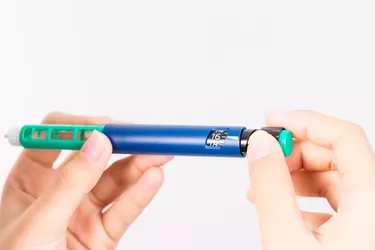
According to the American Diabetes Association, 34 million Americans have been diagnosed with diabetes. Of these, almost 1.6 million have type 1 (T1) diabetes and require treatment with insulin.
Unfortunately, the price of insulin has risen dramatically in recent years and has forced many diabetics to cut back on their treatment - to the detriment of their health. The reasons for the price increases and the lack of a lower-cost generic substitute are complex and not transparent.
Video of the Day
Video of the Day
Here are the factors that seem to be keeping the cost of insulin so high.
Why Is Insulin So Expensive?
In the first place, three companies – Eli Lilly, Novo Nordisk and Sanofi – control 90 percent of the world's supply of insulin. In many countries, only one of these companies is a supplier, so they have a monopoly and can set whatever price they want.
Although they're not considered a monopoly, these three companies have continuously raised the list price for insulin over the years in concert with each other and have acted to shut out any competitors.
Consider also: What Is Comprehensive Medical Insurance?
Why Doesn’t a Generic Exist?
Although generic insulin has been developed by other manufacturers, they are being paid by the three major producers not to produce and sell their generic insulin in the market. This strategy is known as a pay-for-delay agreement in which the generic manufacturer recognizes the original patents of the pharmaceutical company and agrees not to enter the market.
This arrangement actually makes it legal for one manufacturer to pay another manufacturer to not become a competitor by entering the market. As a result, there is no generic insulin on the market.
What Market Forces Are at Work?
The insulin manufacturers claim they have to raise list prices in order to meet the demands of the pharmacy benefits managers (PBMs) and the health insurance companies. They say that the PBMs, the pharmacies and the health insurance companies are all trying to negotiate for more rebates, fees and discounts.
A study from the American Diabetes Association in 2018 found that these negotiations between all the intermediaries for an increased share of the profits forced the manufacturers to raise list prices.
These increased costs in the supply chain get passed on to the insurance plans, which in turn leads to higher premiums and higher co-pays for the consumer. It's the end-user who winds up paying for all the increased profits that each party takes in the distribution of insulin.
The ADA study noted that the lack of transparency in the insulin supply chain made it impossible to determine exactly how much profit each party received and exactly who was at fault for the rise in prices. As you might expect, each party blamed the others.
Consider also: The Average Cost of Prescription Drugs Without Insurance
What Is the Role of Patents?
Patents are intended to protect the owner's investment in research and development and give them time to recoup their expenses. However, patents are supposed to have a limited time frame until they expire. But that's not the case with insulin.
While the major insulin manufacturers have patents on their insulin formulas that have expiration dates, they simply make small changes to the formula or tweak their manufacturing processes and apply for new patents. In this way, they are able to continue to enjoy the benefits of patent protection year after year with no apparent end.
Although generic insulin has been developed by other manufacturers, they are being paid by the three major producers not to produce and sell their generic insulin in the market.
What Does It Mean to Diabetics?
Currently, there is no cure for type 1 diabetes. Treatments have focused mostly on managing diabetes with insulin, diet and exercise. Unfortunately, the rise in prices has forced many diabetics to cut back on their prescriptions for insulin, especially for older people living on a fixed income. This practice is both unsafe and unsound because it leads to serious complications.
What Organizations Are Working to Change It?
The Open Insulin Foundation is a non-profit set up to provide insulin at affordable prices. Their goal is to develop insulin manufacturing processes that can be located in communities and supply the local citizens with affordable insulin.
Consider also: How Does GoodRx Work?